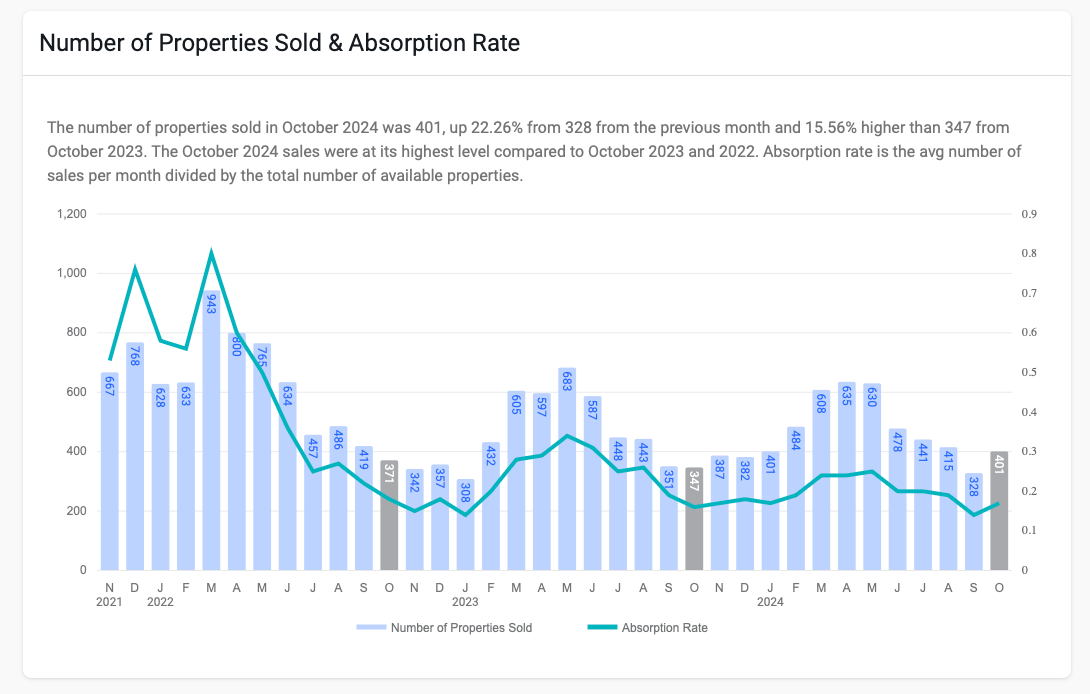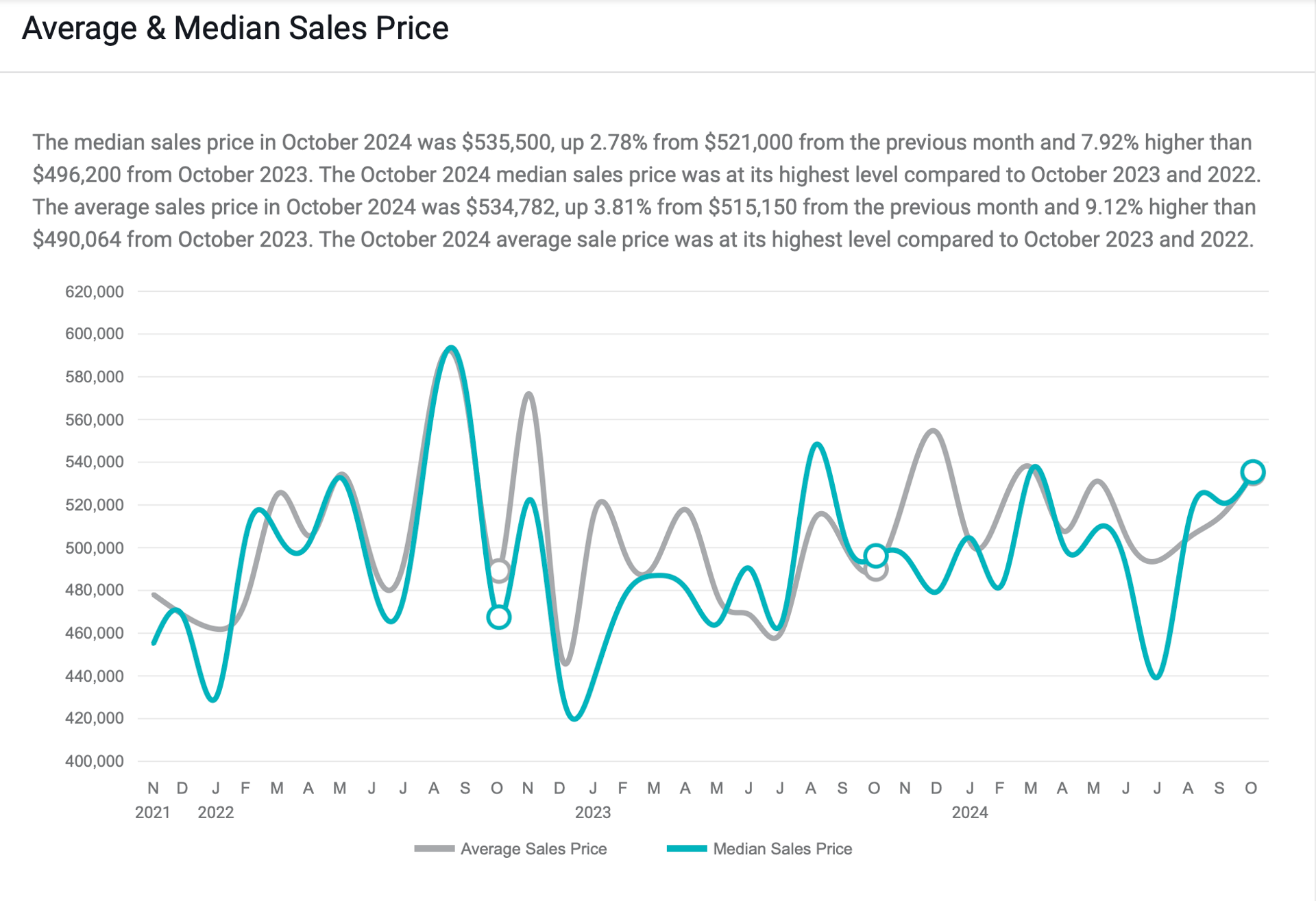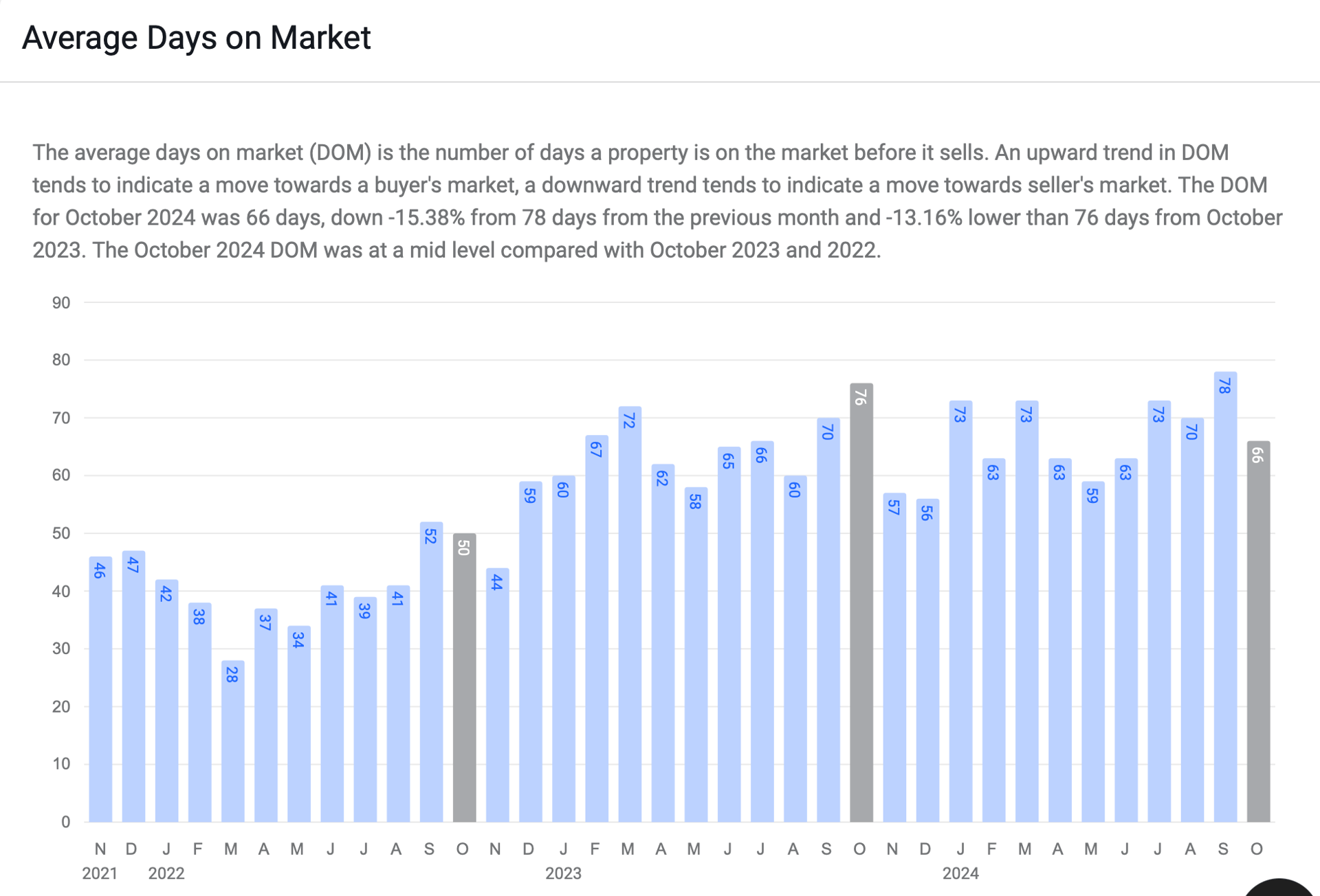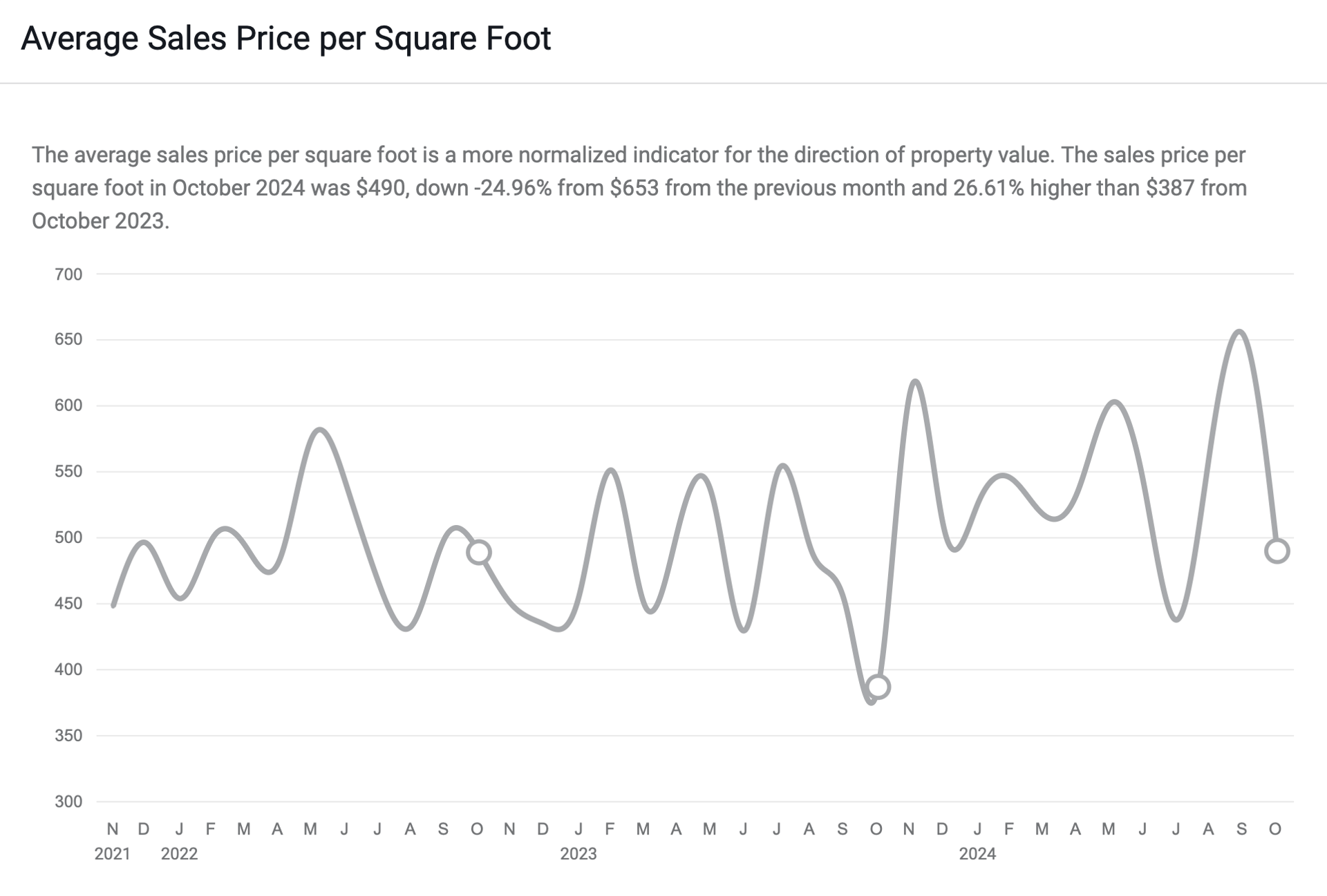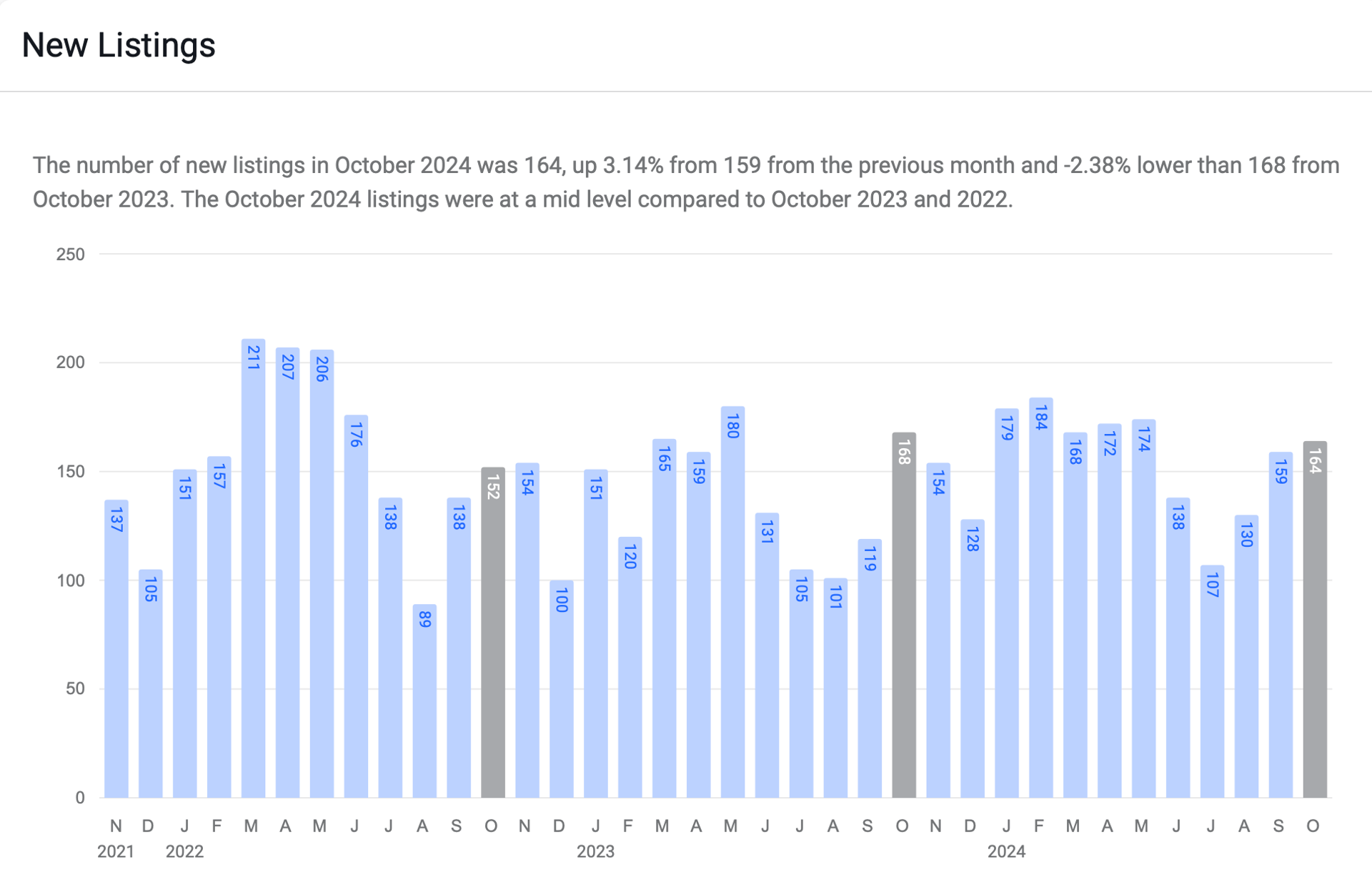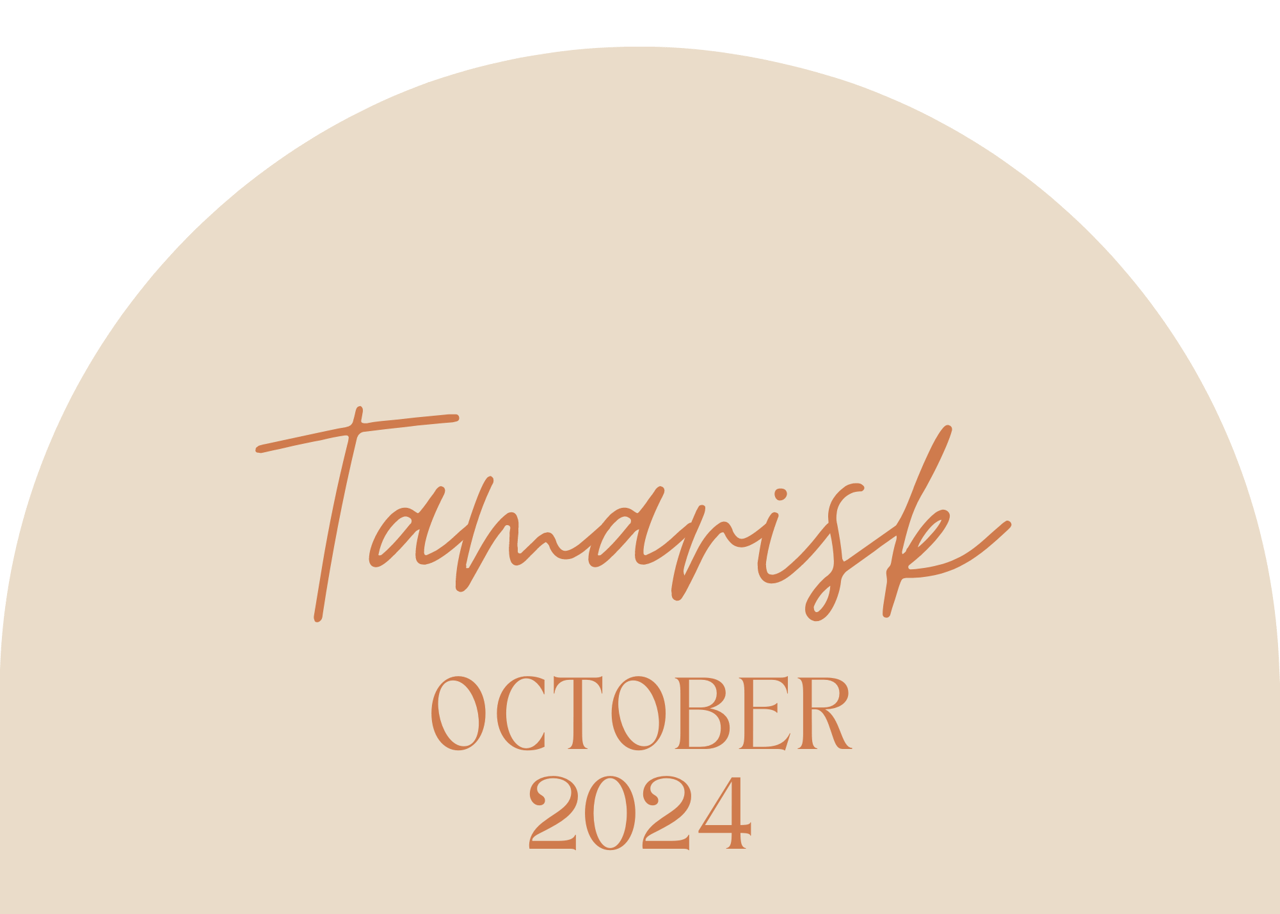Coachella Valley Real Estate Market Analysis - October 2024
Overall Market Overview
The Coachella Valley real estate market, both for single-family homes and condos, is navigating a period of adjustment as rising inventory and a slower pace of sales redefine market dynamics. In the single-family home segment, active listings have surged to 1,649, offering buyers more selection and consequently greater negotiating power. The months' supply inventory (MSI) of 5.89 is a stark contrast to the more competitive conditions observed in mid-2022, when MSI hit a low of 2.05. This increase in inventory signals a shift toward a buyer’s market, a trend further supported by a stable price per square foot, which hovers around $385. While sellers are maintaining prices close to recent highs, the steady absorption rate of 0.17 and longer days on market indicate that properties are no longer moving at the rapid pace seen in the recent boom. New listings remain consistent, with 684 fresh properties entering the market, signaling that seller interest is stable even amid these changes.
In this environment, buyers have newfound leverage, with the opportunity to explore multiple options and take more time to make purchasing decisions. Conversely, sellers may need to revisit their pricing strategies and focus on appealing to a more discerning buyer base. Properties that were once snapped up in record time now face longer periods on market, which might push some sellers to consider competitive pricing adjustments or strategic upgrades to capture buyer interest. The gradual cooling in the single-family home market suggests that we’re moving away from the high-intensity, low-inventory conditions of recent years and into a more balanced, sustainable market phase.
The condo market tells a similar story, underscoring the broader market’s shift toward stability. With a median price of $449,999 and an average price of $502,816, condos have maintained relative price stability but are still down slightly from peak values earlier in the year. The sales-to-list price ratio remains close to 97%, with buyers now securing properties closer to listing prices, indicative of reduced competitive pressure. Active inventory in the condo segment has increased to 745 units, and the MSI has reached 6.26, marking a transition into a clear buyer’s market. This higher supply, combined with an average DOM of 66 days, reflects a recalibrated pace where buyers have more time to consider their options and less urgency to rush into a purchase. The steady price per square foot around $352 further emphasizes that while values are holding, the market dynamic is tilting in favor of buyers.
For condo sellers, this evolving landscape requires a more strategic approach. With abundant choices available to buyers, properties that are priced competitively and marketed effectively will have the upper hand in capturing buyer interest. Sellers who adjust their expectations and consider realistic pricing are more likely to see traction, while those holding out for top-of-market prices may find their properties lingering longer than anticipated. The consistent influx of new listings, with 286 condos entering the market in October, means that sellers will need to stand out amidst increasing inventory. The condo market’s shift is a sign of equilibrium being restored, as the frenetic pace of recent years gives way to a more balanced and sustainable market environment.
Palm Springs
The Palm Springs single-family home market is cooling off compared to its high-energy days a couple of years ago. In October 2024, we saw the median sales price settle around $987,500—a noticeable drop from the $1.8 million peak in August 2022. Buyers now have a bit more breathing room, with homes sitting on the market longer, averaging 62 days. The increased inventory—up to 290 active listings—means more choices, and the Months’ Supply Inventory (MSI) has climbed to 9.67. This shift signals that buyers aren’t feeling the pressure to rush their decisions anymore, and sellers might have to adjust their expectations to catch the eye of these more patient buyers.
What’s interesting, though, is that the price per square foot hasn’t fluctuated much and holds strong at $543. This suggests that while overall prices have softened, homes in popular areas or with unique features are still commanding a good value. Sellers who want to stay competitive might need to be realistic with pricing or consider sweetening the deal to stand out. The steady flow of new listings each month—119 in October alone—adds to this new landscape of choices, balancing the market in a way we haven’t seen in a while.
The condo market in Palm Springs is telling a similar story but with its own twist. As of October, the median sales price for condos is $435,000, showing a bit more stability than the single-family segment. However, the condo market is also moving at a slower pace, with condos sitting on the market for an average of 55 days. Inventory is healthy, with an MSI of 5.95, meaning there’s more time for buyers to explore and consider their options before committing. We’re no longer in the days where condos would fly off the market—buyers can afford to take their time, and sellers might find they need to be flexible to close the deal. Even with the slower pace, condos are holding their value per square foot at $372. Inventory has climbed to 220 active listings, and with 89 new condos hitting the market in October, buyers have a range of options to choose from. It’s a more balanced market now, with both sides having the opportunity to negotiate. Sellers who are strategic with pricing and presentation will likely see the most success in this new environment.
Overall, the Palm Springs market is moving into a new phase—one where balance and stability are starting to take the reins after years of intense demand. Across both single-family homes and condos, inventory is up, properties are spending more time on the market, and the MSI is climbing. This shift from the rapid-fire pace of recent years means that buyers now have the advantage of choice and time, giving them more negotiating power. Meanwhile, sellers may need to get creative, either by pricing competitively or by offering incentives to attract interest in an increasingly selective buyer pool. In short, Palm Springs is settling into a more sustainable rhythm. It’s a great time for buyers who were previously put off by the frenetic pace and tight inventory, as they now have the chance to shop around and find the right property at a price that works. Sellers can still achieve good value, but it’s a market that requires strategy and adaptability. This new phase signals a maturing of the market—one that favors thoughtful, well-considered decisions for both sides.
Cathedral City
In Cathedral City's condo market, recent trends reveal a shift towards a more balanced environment as demand softens and inventory builds. The median sales price for condos in October 2024 stood at $285,000, down from the heights seen earlier, with an average sales price of $329,818. While sales-to-list ratios remained around 96.28%, indicating that some negotiation room exists, the absorption rate stayed low at 0.24, showing a slower turnover rate compared to previous years. This low absorption rate is consistent with the increased days on market (DOM), which averaged 88 days in October—an indication that buyers are taking longer to make purchasing decisions, resulting in more properties sitting on the market for extended periods.
Active inventory for condos in Cathedral City was at 46 units in October, paired with an MSI of 4.18, suggesting that the market currently favors buyers. This elevated inventory, coupled with a steady flow of new listings—19 properties entering the market in October—provides potential buyers with ample choice and leverage in negotiations. Despite these conditions, price per square foot remains relatively stable, and while the market is cooling, it retains enough buyer interest to prevent significant drops in value. Sellers in this market are increasingly advised to price competitively to stand out in a landscape where the abundance of choices has tilted power back toward buyers.
In parallel, Cathedral City’s single-family home market reflects a similarly moderated pace, with inventory building up and sales showing signs of cooling. The median sales price in October 2024 was $559,000, reflecting stability, though sales-to-list price ratios have softened slightly, averaging around 96.99%. Properties are also taking longer to sell, with an average DOM of 76 days. With an active inventory of 324 homes and an MSI of 4.82 months, single-family homes are moving toward a more balanced state, where buyers have more time to consider their options without rushing to make offers. The absorption rate of 0.21 reinforces this moderated demand, suggesting that while buyers remain active, they aren’t pushing prices upward at the same rate seen in previous years.
Across both the condo and single-family segments, Cathedral City's real estate market is undergoing a recalibration from the fervent demand of prior years. The cumulative effect of increasing DOM, steady or growing inventory, and moderated price growth suggests that the market is cooling, giving buyers more negotiating power and choice. This gradual transition to a more balanced market provides opportunities for buyers seeking value and places pressure on sellers to adjust their pricing strategies accordingly. As Cathedral City continues to navigate this shift, both buyers and sellers will need to adapt to a market that no longer operates with the urgency seen during peak demand.
Rancho Mirage
In Rancho Mirage, the single-family home market continues to evolve, with October 2024 showing a median sales price of $1,150,000 and an average sales price of $1,452,966. These prices reflect a steady trend, maintaining value in a market that has seen fluctuating demand over the past two years. The sales-to-list price ratio of 97.21% suggests that buyers are negotiating but still close to asking prices, indicative of a balanced market. Homes sold at a slower pace, with an average of 67 days on the market, showing that the heightened competition and rapid turnover seen in previous years have waned. Inventory remains elevated, with an MSI (Months’ Supply of Inventory) of 6.28, further supporting a shift towards a buyer’s market.
For condos in Rancho Mirage, the trends mirror those seen in single-family homes but with slightly different dynamics. The median sales price in October 2024 was $518,750, while the average sales price was $506,375, both of which show stability but at a lower price point compared to single-family properties. Condos have a similar sales-to-list price ratio of 96.08%, and they are taking longer to sell, with an average DOM of 90 days. Inventory is ample, with an MSI of 6.42, indicating that buyers have plenty of options, which may contribute to longer negotiation periods and slower closing times. The data underscores a softening in the condo market, with ample inventory and buyer-friendly conditions, which may prompt sellers to be more strategic in pricing.
Together, the Rancho Mirage market for both single-family homes and condos is transitioning into a more balanced state after years of intense demand and limited supply. Buyers now have more leverage and options as inventory has risen and days on market have lengthened. Sellers, on the other hand, are facing a market that demands competitive pricing and flexibility to attract offers. As Rancho Mirage settles into this new phase, the market presents opportunities for both buyers and sellers to engage thoughtfully, with a focus on value rather than urgency. This shift suggests a maturing real estate environment where stability and sustained demand provide a foundation for long-term growth, albeit at a more measured pace.
Palm Desert
In Palm Desert, the single-family home market continues to demonstrate resilience, with steady demand and slight adjustments in pricing trends. As of October 2024, the median sales price for single-family homes sits at $599,000, with an average sales price of $667,862. Homes are selling close to list price, with a sales-to-list price ratio at 98.25%, indicating sellers are largely maintaining their pricing power. The absorption rate remains low at 0.21, suggesting that while sales are consistent, the market is taking a bit longer to absorb available inventory, as reflected in the 69 days on market (DOM) for homes in this segment. The active inventory has expanded to 273 units, resulting in a months’ supply of inventory (MSI) at 4.71, providing buyers with a broader selection and hinting at a gradual shift towards a more balanced market.
The condo market in Palm Desert mirrors some of the trends observed in single-family homes, though with a few notable differences. October 2024 data shows a median sales price of $500,000 for condos, and an average sales price of $511,857, slightly below the peak figures seen earlier in the year. The sales-to-list price ratio remains strong at 97.12%, indicating that condo sellers are also achieving prices close to their expectations. However, condos are experiencing a longer DOM of 63 days, and the active inventory stands at 276 units, which translates to an MSI of 6.42. This higher MSI compared to single-family homes points to a more favorable environment for condo buyers, with more choices and potentially increased negotiation leverage.
Overall, the Palm Desert real estate market in October 2024 is characterized by increased inventory across both single-family homes and condos, along with stable but slightly moderated pricing. While demand remains steady, the higher inventory levels and extended DOM suggest that buyers now have more options and may be taking more time to make purchasing decisions. Sellers in both segments are likely to face a more competitive landscape, particularly in the condo market, where the higher MSI indicates a more pronounced shift towards a buyer’s market. This evolving dynamic is creating a balanced market atmosphere in Palm Desert, providing opportunities for both buyers seeking choice and sellers aiming to capitalize on consistent demand.
Indian Wells
The real estate market in Indian Wells presents a nuanced picture across single-family homes and condos, reflecting both high-end price stability and extended supply. For single-family homes, October 2024’s median sales price stands at $1,650,000, with an average sales price of $2,057,600. The sales-to-list price ratio of 100.65% suggests that sellers are receiving offers close to their asking prices, showing resilience in this luxury market. However, with only five single-family homes sold and an absorption rate of 0.09, sales are occurring at a slower pace, indicative of a more selective buyer pool. The MSI for single-family homes is high at 11.2 months, highlighting that inventory significantly outweighs demand, creating a strong buyer’s market. Additionally, with active inventory at 56 homes, buyers have a wide range of options, likely leading to extended decision-making times.
The condo market in Indian Wells echoes similar trends but with unique dynamics. In October 2024, the median condo sales price was $735,000, with an average sales price of $980,000. Despite a slightly lower price range compared to single-family homes, the condo market is experiencing even more substantial supply-demand imbalances. Only three condos were sold, reflecting a limited volume of transactions amidst a rising inventory. The MSI for condos is high at 12 months, and the absorption rate remains low at 0.08, further reinforcing the slow market pace. Condos are spending an average of 93 days on the market, suggesting that buyers are taking their time evaluating options, while sellers may need to consider more competitive pricing or enhanced marketing efforts to stimulate interest.
Overall, Indian Wells showcases a market in transition. Both single-family homes and condos exhibit elevated inventory levels with extended days on the market, indicating a shift toward a buyer’s market. While sellers are still achieving close to their asking prices, the high MSI in both segments points to a cooling period where buyers hold more negotiating power. This environment provides buyers ample choices and time for deliberation, while sellers may need to adjust expectations in pricing and marketing strategies to accommodate this more competitive market landscape. As inventory remains abundant, the market may continue to favor buyers in the near term, promoting a balanced environment after years of high demand.
La Quinta
La Quinta's single-family homes and condo markets have shown notable shifts in recent years, with both segments reflecting a move toward stabilization and balanced market conditions. In the single-family home market, October 2024 saw a median sales price of $736,450 and an average sales price of $1,132,803, with a sales-to-list price ratio of 97.47%. Homes in this segment are spending more time on the market, averaging 62 days, and the absorption rate remains low at 0.19, indicating a moderate pace of sales relative to the number of available properties. Inventory levels have increased, with 350 active listings and a month’s supply inventory (MSI) of 5.22, giving buyers more choices and positioning the market in a more neutral territory.
In La Quinta's condo market, the latest data for October 2024 shows a median sales price of $640,000 and an average sales price of $711,500, with a close-to-listing sales ratio at 96.82%. Condo sales remain moderate, with ten units sold in October, while days on market (DOM) increased to 61, highlighting a more deliberate buying process in this segment. The absorption rate sits at 0.14, reflecting similar trends to the single-family market, where supply has started to outpace demand slightly. With 69 active listings and an MSI of 6.9, condo buyers in La Quinta find themselves in a position of increased choice and negotiating power.
Overall, La Quinta’s real estate landscape has transitioned into a more balanced market, with both single-family homes and condos displaying longer days on market and increased inventory. These dynamics provide buyers with greater leverage, especially compared to the highly competitive conditions of previous years. Sellers, on the other hand, may need to adopt competitive pricing strategies to attract buyers, as the market recalibrates after a period of high demand and limited supply. This balanced environment is likely to foster a more sustainable market for both buyers and sellers moving forward.
Indio
The real estate market in Indio is experiencing a noticeable shift, with both single-family homes and condos showing signs of moderation after the rapid growth of recent years. Inventory levels have risen across both segments, and properties are spending longer on the market, creating a more balanced environment where buyers have more options and less urgency. In the condo market, where months of supply (MSI) has reached 7 months, buyers are finding more leverage, as the abundance of inventory gives them room to negotiate. This cooling trend in the condo sector suggests that sellers will need to be strategic in their pricing and property presentation to attract offers in a less competitive landscape. The absorption rate and days on market indicate that the market is moving away from the high-demand, low-supply conditions that once pushed prices upward.
Meanwhile, the single-family home segment, though also showing signs of cooling, remains relatively competitive with an MSI around 5.76 months. Prices are still holding close to list values, highlighting sustained demand and value retention despite the longer sales cycles. This stability in pricing shows that single-family homes in Indio continue to appeal to buyers, especially those seeking affordability and lifestyle benefits in the region. With inventory on the rise, the Indio market is gradually shifting towards more traditional dynamics, allowing buyers to be more deliberate while still requiring sellers to be mindful of pricing. This evolving landscape reflects broader regional trends and points towards a sustainable market balance, where both buyers and sellers can negotiate on more even footing moving forward. As interest rates and economic conditions evolve, they will play a key role in determining whether this trend continues or shifts further.
Overall
To conclude, the Coachella Valley real estate market in October 2024 reflects a notable shift toward stability and balance across its diverse cities and property types. Increased inventory levels, longer days on market, and moderated pricing trends characterize a market environment where buyers have regained some leverage, creating opportunities for more thoughtful decision-making. This transition from the previously high-pressure, fast-paced conditions offers buyers a chance to explore their options, negotiate, and ultimately find properties that align with their needs. For sellers, this new landscape calls for strategic adjustments, especially in terms of competitive pricing and value-driven marketing to capture buyer interest.
As the market recalibrates, both buyers and sellers are encouraged to adopt a realistic approach. Buyers can take advantage of the broader selection and reduced urgency, while sellers must adapt to attract the increasingly discerning buyer base. Overall, the Coachella Valley is entering a more sustainable phase that provides a solid foundation for steady, long-term growth. This balanced market environment allows for mutually beneficial transactions, making it an opportune moment for buyers and sellers to engage in the market thoughtfully and strategically. As this trend continues, it signals a maturing real estate landscape—one that offers stability and opportunity in equal measure.

